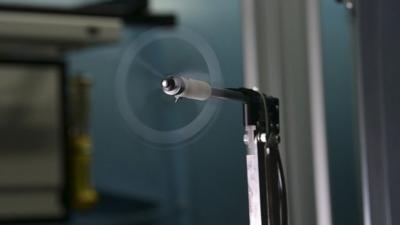Working To Gather Data On The Most Basic Level
Researchers from the U.S. Army Research Laboratory and Bell Helicopter, a Textron Inc., company, met in June to further advance the development of a micro unmanned aerial system or UAS. The UAS is a miniature, lightweight reconnaissance vehicle that Soldiers can carry onto the battlefield and deploy in a confined space.

Bell representatives attended ARL's open campus event in November 2016. Following a year and a half of relationship building and information sharing, signed a five-year cooperative research and development agreement, or CRADA, in March 2018. "The CRADA lets us work together," said Dr. John Hrynuk, a mechanical engineer in ARL's Vehicle Technology Directorate. "We're trying to get data on the fundamental level, to build up a knowledge base of vehicles, because their expertise is in designing the vehicles, whereas our expertise is the fundamentals of them."
Hrynuk noted this is new way of doing business between ARL and Bell. "We want new technology; they want new vehicles," he said. "Together, we want to enhance technologies for the Soldiers -- that's what makes it the absolute perfect collaboration."
Bell engineers, Levi Hefner and Dakota Easley recently visited ARL to use its wind tunnel to perform experiments on the micro UAS.
The visit was prompted by vehicle control challenges Bell researchers had observed in early flight testing. With the help of ARL scientists and equipment, Bell engineers were able to isolate their earlier challenges and improve the performance of the aerial vehicle. "The wind tunnel here at ARL has been beneficial in providing data that explains why certain things are happening on the control side," Hefner said. "Now we're able to better analyze our tests to enhance the performance of our vehicles."
So far, the joint effort to improve the UAS has been largely successful, officials said. The two parties worked effectively together by taking advantage of their respective strengths to manage different aspects of the development process.
"This collaboration is great because we're heading into a new design space with these small vehicles," Hefner said. "ARL has the resources and expertise to help us out, and together we can build a better vehicle than either of us could build alone."

Dr. Jaret C. Riddick, VTD director, said the main mission of this collaboration is to combine the resources of both establishments to develop technologies to protect Soldiers. "I am very excited about this collaboration with Bell, and to have Levi and Dakota working side-by-side with ARL researchers in our laboratories here at APG," Riddick said. "Partnering with industry early on in the discovery phase will allow us to accelerate the maturation and transition of exceptional outcomes from our basic and applied research objectives and will enable us to accelerate getting innovative technology into the hands of the warfighter faster."
Bell's Vice President of Innovation, Scott Drennan, commented on how the use of ARL facilities and resources offers new avenues for the rapid production and advanced prototyping of next-generation vehicles. "We were excited for the opportunity to send our professionals to ARL to work engineering problems with them, and bring those technical lessons learned back to Bell to aid the rapid development of new technologies," Drennan said. "We share a common goal of developing technologies that will move the industry forward to better support our military, and believe this successful collaboration brings us one step closer."
The work between ARL and Bell is one example of the many collaborations with industry and military. The benefit of this collaboration is to bring advanced technologies and capabilities to the warfighters of tomorrow.
(Images provided with U.S. Army news release)
 ANN's Daily Aero-Term (04.25.24): Airport Rotating Beacon
ANN's Daily Aero-Term (04.25.24): Airport Rotating Beacon ANN's Daily Aero-Linx (04.25.24)
ANN's Daily Aero-Linx (04.25.24) Klyde Morris (04.22.24)
Klyde Morris (04.22.24) Airborne 04.24.24: INTEGRAL E, Elixir USA, M700 RVSM
Airborne 04.24.24: INTEGRAL E, Elixir USA, M700 RVSM Airborne 04.22.24: Rotor X Worsens, Airport Fees 4 FNB?, USMC Drone Pilot
Airborne 04.22.24: Rotor X Worsens, Airport Fees 4 FNB?, USMC Drone Pilot




